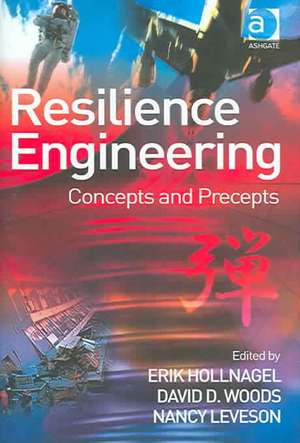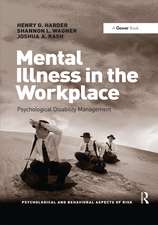Resilience Engineering: Concepts and Precepts
Autor David D. Woods Editat de Erik Hollnagelen Limba Engleză Hardback – 28 ian 2006
| Toate formatele și edițiile | Preț | Express |
|---|---|---|
| Paperback (1) | 382.85 lei 3-5 săpt. | +35.76 lei 4-10 zile |
| CRC Press – 19 sep 2006 | 382.85 lei 3-5 săpt. | +35.76 lei 4-10 zile |
| Hardback (1) | 1124.16 lei 6-8 săpt. | |
| CRC Press – 28 ian 2006 | 1124.16 lei 6-8 săpt. |
Preț: 1124.16 lei
Preț vechi: 1370.93 lei
-18% Nou
Puncte Express: 1686
Preț estimativ în valută:
215.18€ • 233.81$ • 180.86£
215.18€ • 233.81$ • 180.86£
Carte tipărită la comandă
Livrare economică 21 aprilie-05 mai
Preluare comenzi: 021 569.72.76
Specificații
ISBN-13: 9780754646419
ISBN-10: 0754646416
Pagini: 416
Ilustrații: Includes 48 b&w illustrations
Dimensiuni: 156 x 234 x 32 mm
Greutate: 0.88 kg
Ediția:New ed
Editura: CRC Press
Colecția CRC Press
ISBN-10: 0754646416
Pagini: 416
Ilustrații: Includes 48 b&w illustrations
Dimensiuni: 156 x 234 x 32 mm
Greutate: 0.88 kg
Ediția:New ed
Editura: CRC Press
Colecția CRC Press
Public țintă
Academic and Professional Practice & DevelopmentCuprins
Contents: Preface; Prologue: resilience engineering concepts, David D. Woods and Erik Hollnagel. Emergence: Resilience: the challenge of the unstable, Erik Hollnagel; Systems are ever-changing, Yushi Fujita; Essential characteristics of resilience, David D. Woods; Defining resilience, Andrew Hale and Tom Heijer; Nature of changes in systems, Yushi Fujita; Complexity, emergence, resilience, Jean Pariès; A typology of resilience situations, Ron Westrum; Resilient systems, Yushi Fujita; Incidents - markers of resilience or brittleness?, David D. Woods and Richard I. Cook; Resilience engineering: chronicling the emergence of confused consensus, Sidney Dekker. Cases and Processes: Engineering resilience into safety-critical systems, Nancy Leveson, Nicolas Dulac, David Zipkin, Joel Cutcher-Gershenfeld, John Carroll and Betty Barrett; Is resilience really necessary? the case of railways, Andrew Hale and Tom Heijer; Systems are never perfect, Yushi Fujita; Structure for management of weak and diffuse signals, Lars Axelsson; Organisational resilience and industrial risk, Nick McDonald; An evil chain mechanism leading to failures, Yushi Fujita; Safety management in airlines, Arthur Dijkstra; Taking things in one's stride: cognitive features of two resilient performances, Richard I. Cook and Christopher Nemeth; Erosion of managerial resilience: from Vasa to NASA, Rhona Flin; Learning how to create resilience in business systems, Gunilla Sundström and Erik Hollnagel; Optimum system safety and optimum system resilience: agonistic or antagonistic concepts?, René Amalberti. Challenges for a Practice of Resilience Engineering: Properties of resilient organisations: an initial view, John Wreathall; Remedies, Yushi Fujita; Auditing resilience in risk control and safety management systems, Andrew Hale, Frank Guldenmund and Louis Goossens; How to design a safety organization: test case for resilience engineering, David D. Woods; Rules and procedures, Yushi Fujita; Distancing throu
Notă biografică
Erik Hollnagel became Industrial Safety Chair at MINES ParisTech, France, in 2006, after having been Professor of Human-Machine Interaction at Linköping University, Sweden, since 1999. He is an internationally recognised specialist in the fields of industrial safety, human reliability analysis, cognitive systems engineering, and complex human-machine systems and author of more than 350 publications including 12 books. David D. Woods is Professor at the Institute for Ergonomics, Ohio State University, USA, and Past-President of the Human Factors and Ergonomics Society. He currently serves on a National Academy of Engineering/Institute of Medicine Study Panel to improve healthcare systems and on a National Research Council panel on research to define the future of the national air transportation system. Nancy Leveson is Professor of Aeronautics and Astronautics at the Massachusetts Institute of Technology, USA. She works in the areas of system safety, human-computer interaction and software engineering, in a variety of industries including nuclear power, space systems, aviation, medical devices and transportation.
Recenzii
'This is the most thought-provoking collection of papers I've read in a very long time. They are written by the best in the field at the top of their form. Resilience is a notion whose time has come. We cannot realistically expect to eliminate adverse events and still stay in business. But we can strive to achieve greater robustness towards our operational hazards. This book tells us how to do it and why it's necessary.' James Reason 'This book is the next frontier for improving safety in healthcare, aviation, nuclear power and other high technology systems. Innovative and intellectually challenging, Resilience Engineering emphasises the importance of learning about the positive side of safety management; focusing on how frontline staff foresee, adapt and recover from problems. It is an essential read for managers, regulators, academics and operators alike.' Jane Carthey, National Patient Safety Agency in England and Wales, UK 'From my point of view the main achievement of the book is that it provides a turn in the perspective on system safety, from a mainly reactive "hindsight" perspective reflected in the numerous attempts to learn from events and accidents to a more proactive one focusing on the interrelation of safety and the characteristics of organizations as dynamic systems. Although I would hesitate to share the view of Dave Woods that this already represents a paradigm shift in safety research, I am at least convinced that the views and ideas presented in the book provide very important contributions to the understanding of high reliability organizations.' Human Factors and Ergonomics Society Newsletter. 2006 Featured in list 'Selected Works on Resilience, 2001-12' in Chronicle of Higher Education's The Chronicle Review, May 10, 2013
Descriere
For Resilience Engineering, 'failure' is the result of the adaptations necessary to cope with the complexity of the real world, rather than a malfunction. Human performance must continually adjust to current conditions and, because resources and time are finite, such adjustments are always approximate. Featuring contributions from leading international figures in human factors and safety, Resilience Engineering provides thought-provoking insights into system safety as an aggregate of its various components - subsystems, software, organizations, human behaviours - and the way in which they interact.

























